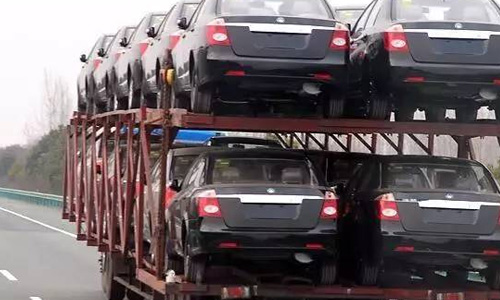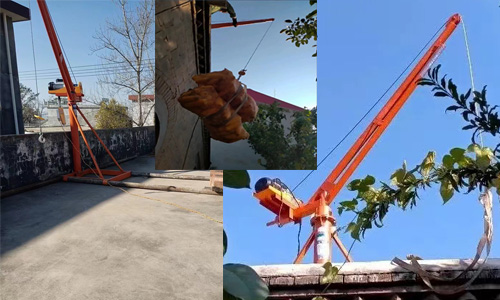This article will provide a comprehensive overview of hoists, including their definition, types, applications, how to use them, etc. Whether you’re interested in distributing hoists, using them personally, or renting them, you’ll find answers in this article.
What Is A Hoist?
A hoist consists of an upper and lower hook assembly, a power unit (manual, electric, hydraulic, pneumatic), and a lifting mechanism (chain, wire rope, sling, etc.), and it is a mechanical device used to lift or lower heavy objects. It significantly saves manpower and is widely used in construction, manufacturing, highway construction, agricultural production, power construction, and other fields.
There are many types of hoists available to meet your various needs.
Different Types Of Hoists
In the market, hoists are commonly classified into two main categories: manual hoists and electric hoists. Based on the lifting method, they are further divided into manual wire rope hoists, manual chain hoists, electric wire rope hoists, and electric chain hoists. Among them, manual chain hoists include chain block hoists, lever hoists, heavy-duty chain hoists, light-duty chain hoists, and more. Electric hoists also encompass micro electric hoists, standard electric hoists, explosion-proof hoists, wind power hoists, and others.
For specific requirements, please contact Liftpand’s professional sales team. Below is just a brief introduction based on the two main categories.
Manual hoists
Manual hoists utilize a hand chain or a lever as their power mechanism, requiring the operator to manually pull the chain or move the handle up and down to control the lifting or lowering of the hoist.
Manual hoists have a simple structure, and they are cost-effective and easy to maintain.
The most common specifications for manual hoists typically do not exceed 20 tons, making them compact, lightweight, and easy to carry. They are convenient for single-person operation and find widespread application, especially in outdoor environments where power sources are unavailable or conditions are harsh, highlighting their advantages.
Powered hoists
An electric hoist, as the name suggests, operates using electricity as its power source, driving the lifting chain or wire rope to raise or lower heavy objects.
Unlike manual hoists, electric hoists require minimal effort; you simply need to connect them to a power source and operate them by pressing a handle or using a wireless remote control.
While electric hoists may have limitations in terms of application areas, they offer time and labour savings, low post-sales service rates, and high customer satisfaction. The use of electric hoists significantly enhances both productivity and safety.
Common Applications of The Hoist
Whether at home, in warehouses, factories, on highways, or at ports, you can find hoists wherever heavy lifting or moving of objects is required. Below, we’ll list some application areas of hoists, including but not limited to the following:
Hoist for Construction
Hoists are commonly used in construction projects as a type of construction machinery. On construction sites, hoists are frequently used for lifting materials such as steel bars, cement, and bricks.
Hoist for logistic
In large workshops, hoists are often seen used for moving and loading/unloading production materials.
During transportation, hoists are used for hoisting and securing large objects.

Hoist for Garage
Mini-electric hoists are commonly found in warehouses and are used for lifting and lowering car frames or storage racks.
Hoist for agriculture
Especially during busy farming seasons, manual chain hoists and lifting winches are invaluable tools for farmers to load and unload grain.

Hoist platform
Hoists are not only used independently but are also commonly paired with various structures such as I-beams, mobile frames, jib cranes, and gantry cranes.
Benefits Of Using A Hoist
Let’s look through how the hoist helps your business.
Using hoists can greatly save manpower. The use of hoists has changed the era of manual handling of objects in the past, and the use of electric hoists only requires a gentle press of a button to lift or move dozens of tons of goods up, down, or sideways.
Hoists not only lighten the workload for employees but also significantly save time, enhancing productivity and efficiency in production and work.
Using hoists reduces the risk of personnel injury and saves costs.
In some special situations, such as high-dust workshops or explosion-proof workshops, customized electric chain hoists must be used for loading and unloading materials.
What To Consider When Choosing The Right Hoist?
Please consider the following aspects, among others, when selecting the appropriate hoist for your needs and scenarios:
Hoist certification
For instance, European-imported hoists require CE and GS certifications, while Australian imports need AS certification.
If you’re an importer, it’s crucial to understand the corresponding import policies to avoid clearance issues.
Hoist environment
The usage environment determines the type of hoist you should choose, whether manual or electric.
For manual hoists, decide between heavy-duty or light-duty.
For electric hoists, choose between wire rope hoists or chain hoists, and consider options like custom dustproof or explosion-proof hoists.
If uncertain, Liftpand has a professional technical and sales team to provide reasonable recommendations.
Hoist capacity
Hoist specifications range from 0.25T to 100 T. Different models have varying specifications. Confirm the weight of the object to be lifted; for example, if lifting a 3T object, choose a 5T hoist. Also, consider potential changes in the weight of the object being lifted, and never overload the hoist.
Hoist length
Standard lifting heights for hoists are 3M and 6M. Whether it’s a wire rope hoist or a chain hoist, the length can be customized. Make sure to confirm this in advance.
Power source
Electric hoists come in different voltage options like single-phase 220V, three-phase 380V, 440V, etc. Confirming the voltage is crucial to ensure compatibility and avoid purchasing a hoist that cannot be used due to a voltage mismatch.
Suspension type
Hoists can be used independently or in conjunction with manual or electric trolleys. If choosing a trolley, confirm the specifications, model, and I-beam size.
Lift speed
Some electric hoists can be customized with a frequency converter to offer both fast and slow speeds. Prices may increase accordingly. Choose based on your specific requirements.
Should I Buy Or Rent A Hoist?
Buying or renting depends on your usage frequency. If you need to use it frequently in a factory, it’s advisable to buy. If you only need a 100T hoist for a single use, renting is more suitable. However, if you need a 1T manual hoist for a single use, it’s still recommended to buy because it’s inexpensive and you might need it again in the future.
Hoist brands
If you’re an importer with your own brand, you can find suitable exporters offering good price-to-quality ratios for OEM production. If you’re using it for personal use, it’s best to choose reputable brands with assured quality and after-sales service. Below are some well-known brands for reference:
KITO https://kito.com/
VITAL https://www.vital.co.jp/
Harbor Freight https://www.harborfreight.com/
Kone https://www.konecranes.com/en-us
Harrington https://www.harringtonhoists.com/
Different countries have their own best-selling brands, so choose the one that suits your location, preferences, and budget.
How To Install A Hoist?
The installation of a manual hoist is straightforward; simply find a suitable location and hang it directly on the hook.
For electric hoists, mini electric hoists and hoists with associated brackets require choosing the appropriate support.
Detailed installation steps for wire rope electric hoists and chain electric hoists should be followed according to the instruction manual.
Electric hoists typically accompany trolleys for use. First, adjust the distance between the trolley wheels, connect the trolley to the hoist body, then mount the entire unit onto the I-beam. Next, install the control box, power line, and hoist hook.
After installing the hoist, it’s important to conduct testing to ensure smooth lifting and lowering, proper limit settings, and remote control functionality before regular use begins.
Common Inspection And Maintenace
Here are some routine checks to prevent unnecessary accidents:
Before using a hoist, always perform a trial pull test.
Upon receiving a hoist, check the packaging for completeness. Remove the hoist and verify the completeness of accessories according to the instruction manual.
Due to transportation, the hoist may experience impacts. Check for loose screws and ensure the chain or wire rope is intact.
If everything appears normal, conduct a trial pull test before regular use.
During hoist operation, pay attention to the wear condition of the chain or wire rope and replace them promptly when necessary.
After using the hoist, store it properly to prevent severe rusting of accessories.
Maintenance of manual hoists is simple; with spare parts and instructional videos, you can perform replacements yourself.
For electric hoists, seek professional assistance for maintenance.
How To Use The Hoist Safely
Lightweight and compact hoists only require strict adherence to the instructions provided, such as avoiding slanted pulls and keeping people clear from underneath the hoist.
For reference, you can consult this article: https://liftpand.com/chain-block/#How_to_Operate_the_Chain_Block_Safely.
Heavy-duty hoists, being specialized equipment, necessitate inspection and operation by trained personnel, along with the possession of appropriate certifications for operating such equipment. For specific requirements, please refer to local regulations.
Hoisting technology trends
With the advancement of technology, the hoist market will become increasingly segmented, with a greater variety of types available. Particularly in the case of electric hoists, there will be a trend towards greater intelligence, automation, and higher safety standards, leading to a wider range of applications.
FAQ:
The Difference Between A Hoist And A Crane .
Hoist generally refers to a small, lightweight single-lifting device capable of only moving up and down.
However, a crane refers to a larger piece of equipment typically consisting of a hoist and a beam, allowing for movement in multiple directions such as up, down, left, and right. Examples include bridge cranes, gantry cranes, and jib cranes.
Do I need to disassemble the hoist for yearly inspection?
The national standards for regular safety inspections of lifting machinery specify that, to ensure life safety, the inspection period for light and small lifting equipment, bridge cranes, gantry cranes, etc., is one year, requiring regular safety inspections every year.
As a small lifting tool, daily inspection and maintenance are necessary, and whether disassembly for inspection is required depends on your frequency of use and the operating environment.

